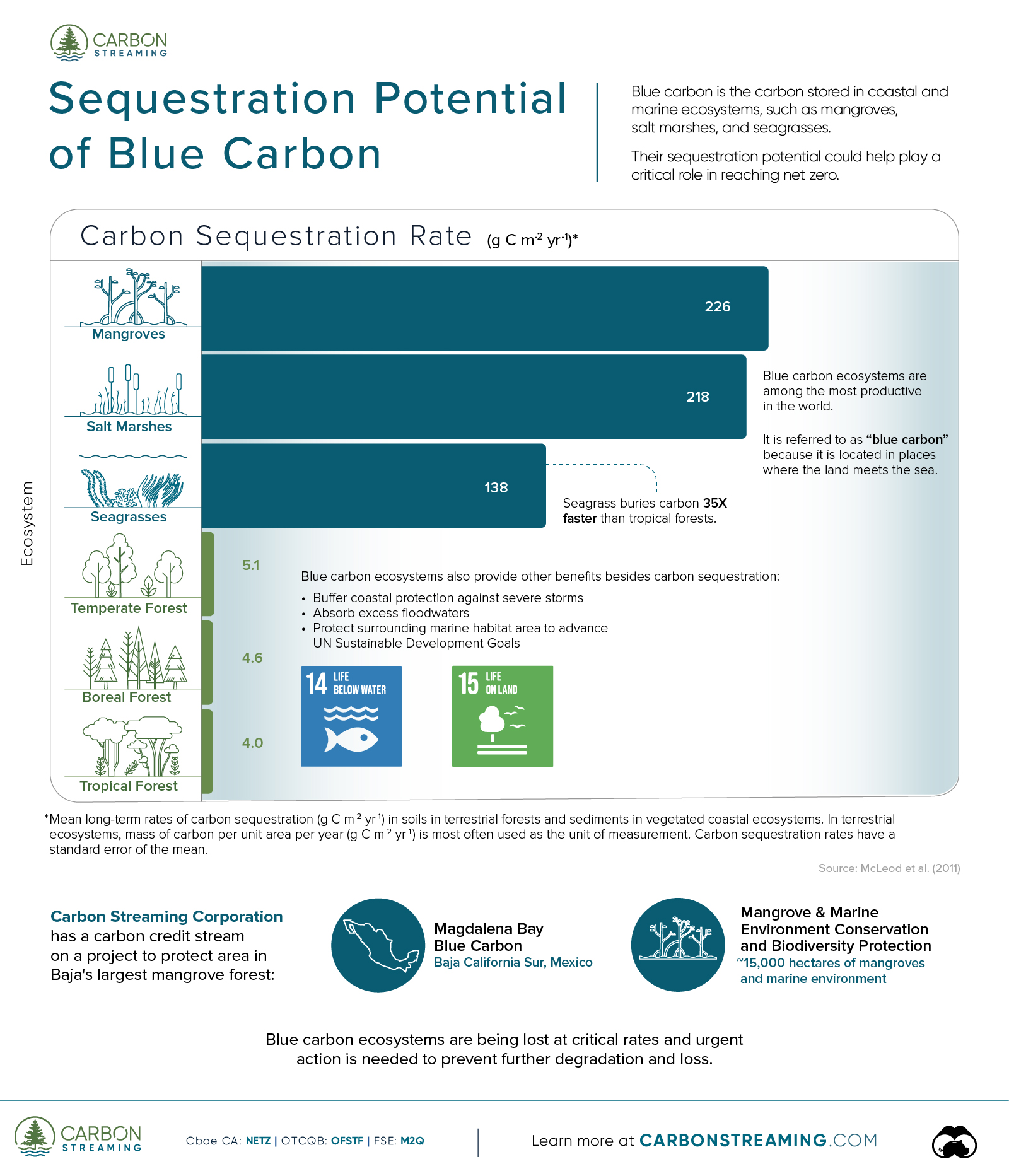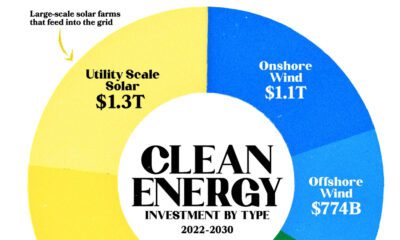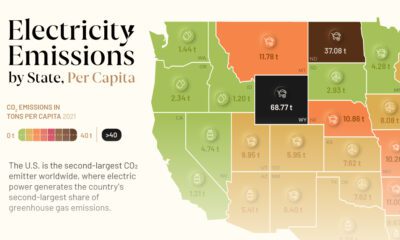
Published
8 seconds ago
on
January 24, 2024
| 18 views
-->
By
Dorothy Neufeld
Graphics & Design
- Alejandra Dander
The following content is sponsored by Carbon Streaming Corporation
How Blue Carbon Combats Climate Change
Today, 33 billion metric tons of carbon is stored in blue carbon ecosystems.
For context, this is equal to 81% of the emissions produced globally in 2023. These blue carbon sinks play an important role in locking away carbon and are found across three main ecosystems:
- Mangroves
- Salt marshes
- Seagrasses
This graphic, sponsored by Carbon Streaming Corporation, illustrates the significant sequestration potential of blue carbon.
Carbon Sequestration Potential by Ecosystem
Blue carbon ecosystems are among the most productive in the world—meaning their plants usually grow a lot each year, and in the process, sequester large amounts of carbon.
In addition, their soils are largely anaerobic (without oxygen) so carbon that gets incorporated into the soils decomposes very slowly and can remain intact and stored for hundreds or even thousands of years.
In fact, mangroves sequester carbon 56 times faster than tropical forests.
| Ecosystem | Carbon Sequestration Rate (g C m-2 yr-1)* |
|---|---|
| Mangroves | 226 |
| Salt Marshes | 218 |
| Seagrasses | 138 |
| Temperate Forest | 5.1 |
| Boreal Forest | 4.6 |
| Tropical Forest | 4.0 |
*Mean long-term rates of carbon sequestration (g C m-2 yr-1) in soils in terrestrial forests and sediments in vegetated coastal ecosystems. In terrestrial ecosystems, mass of carbon per unit area per year (g C m-2 yr-1) is most often used as the unit of measurement. Carbon sequestration rates have a standard error of the mean.
Source: McLeod et al. (2011)
Salt marshes, found largely along the coastlines of North America and Australia, are another highly efficient carbon sink.
As a complex ecosystem, they protect shorelines from flooding and help prevent property damage in nearby communities. Yet between 2000 and 2019, the world lost 561 square miles of salt marshes, equal to around twice the size of Singapore.
One study showed that one hectare of seagrass absorbs the equivalent carbon dioxide as 15 hectares of rainforest each year. This is in part due to the fact that they trap organic matter and sediments that contain carbon.
Meadows of seagrasses, known as the ocean’s ‘lungs’, are found across every continent globally with the exception of Antarctica.
Blue Carbon Rate of Loss
In the last 40 years, 20% of the world’s mangroves have been destroyed due to shrimp farming, palm oil plantations, and other commercial activities. Natural retraction has also played a role.
By some estimates, the world’s unprotected mangroves could be eliminated in the next 100 years.
Disappearing salt marshes are just as concerning. One study showed that their global loss was equal to the size of two soccer fields each hour over the 20 years from 2000 to 2019. This resulted in the release of annual estimated net global emissions equivalent to the annual emissions of 3.5 million cars.
Protecting Vital Ecosystems with Carbon Credits
Blue carbon ecosystems are being lost at critical rates and urgent action is needed to prevent further degradation and loss.
Projects funded by carbon credits ensure that these ecosystems are protected. Through the sale of carbon credits, it is more economically viable for preserving mangroves and salt marshes than using them for other commercial activities.
One example is the Magdalena Bay Blue Carbon Project in Mexico, which protects roughly 15,000 hectares of mangroves and marine environment from shrimp farming seen in nearby areas. The project aims to advance nine UN Sustainable Development Goals (UN SDGs) in its work to protect biodiversity and promote new economic opportunities in local communities.
Over 30 years, the project, which Carbon Streaming has a carbon credit stream agreement, is expected to reduce greenhouse gas emissions of an estimated 25 million tonnes of carbon dioxide equivalent.
The Benefits of Blue Carbon Ecosystems
Blue carbon ecosystems provide other advantages beyond carbon sequestration, such as:
- Buffer coastal protection against severe storms
- Absorb excess floodwaters
- Protect surrounding marine habitat area to advance UN SDGs
By conserving these critical ecosystems, carbon credits play an important role in overcoming climate challenges to help the world reach net zero.

Learn more about Carbon Streaming.

Please enable JavaScript in your browser to complete this form.Enjoying the data visualization above? *Subscribe
Related Topics: #carbon credits #net zero #carbon sequestration #Carbon Streaming #blue carbon
Click for Comments
var disqus_shortname = "visualcapitalist.disqus.com";
var disqus_title = "How Blue Carbon Combats Climate Change";
var disqus_url = "https://www.visualcapitalist.com/sp/how-blue-carbon-combats-climate-change/";
var disqus_identifier = "visualcapitalist.disqus.com-163778";
You may also like
-

Green6 days ago
Every EV Qualified for U.S. Tax Credits in 2024
The number of EVs eligible for U.S. tax credits dropped sharply in 2024. Here is every model that qualifies.
-

Economy2 weeks ago
Visualizing the Top Global Risks in 2024
Here are global risk projections for 2024 as tensions in the Middle East escalate and major economies face elections this year.
-

Environment3 weeks ago
Visualized: What Lives in Your Gut Microbiome?
The human gut microbiome contains a world of microbes. We look at the the bacteria that deeply affect our health and well-being.
-

Green4 weeks ago
Visualized: Global Clean Energy Spending Forecasts (2022-2030)
Global clean energy spending is projected to reach $5.6 trillion by 2030. Which renewable sources are forecast to see the most investment?
-

Green1 month ago
Visualized: Per Capita Electricity Emissions, by State
This graphic showcases electricity emissions by state, highlighting each state’s largest source of power.
-

Green1 month ago
Charted: Global CO2 Emissions by Income Group
We visualize global CO2 emissions by income group, showing the impact of different wealth brackets on carbon generation.
Subscribe
Please enable JavaScript in your browser to complete this form.Join the 375,000+ subscribers who receive our daily email *Sign Up
The post How Blue Carbon Combats Climate Change appeared first on Visual Capitalist.